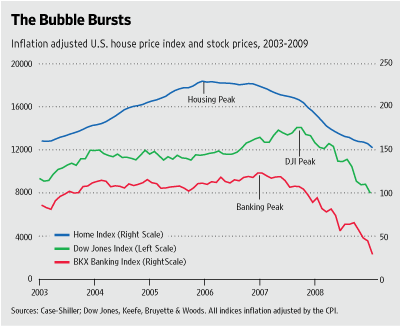A better explanation of what happened is now published in the WSJ today. It may not be the last word but it makes sense.
Why does one large asset bubble — like our dot-com bubble — do no damage to the financial system while another one leads to its collapse? Key characteristics of housing markets — momentum trading, liquidity, price-tier movements, and high-margin purchases — combine to provide a fairly complete, simple description of the housing bubble collapse, and how it engulfed the financial system and then the wider economy.
They believe that the housing bubble was unique because it involved heavy leverage and a low income segment of the population who could not service their debt once property appreciation ended. They were betting that trees grow to the sky. I have lived through other housing bubbles.
In just the past 40 years there were two other housing bubbles, with peaks in 1979 and 1989, but the largest one in U.S. history started in 1997, probably sparked by rising household income that began in 1992 combined with the elimination in 1997 of taxes on residential capital gains up to $500,000. Rising values in an asset market draw investor attention; the early stages of the housing bubble had this usual, self-reinforcing feature.
The 1979 bubble ended with inflation and high interest rates. In those days, however, the down payments and income requirements kept some level of sanity. In 1979, my partner built a custom home in a new gated section of Mission Viejo that was located on a lake. His neighbors on either side also built custom homes but, when the time came to convert from construction financing to permanent home loans, the interest rates were 21% and neither could qualify for the loan in spite of excellent incomes.
The 2001 recession might have ended the bubble, but the Federal Reserve decided to pursue an unusually expansionary monetary policy in order to counteract the downturn. When the Fed increased liquidity, money naturally flowed to the fastest expanding sector. Both the Clinton and Bush administrations aggressively pursued the goal of expanding homeownership, so credit standards eroded. Lenders and the investment banks that securitized mortgages used rising home prices to justify loans to buyers with limited assets and income.
There are You Tube videos of Franklin Raines explaining to Congress in 2004 that single family home values could never decline.
But they did decline and we have seen the consequences. Why did this bubble take down the financial sector of the economy ?
In the equities-market downturn early in this decade, declining assets were held by institutional and individual investors that either owned the assets outright, or held only a small fraction on margin, so losses were absorbed by their owners. In the current crisis, declining housing assets were often, in effect, purchased between 90% and 100% on margin. In some of the cities hit hardest, borrowers who purchased in the low-price tier at the peak of the bubble have seen their home value decline 50% or more. Over the past 18 months as housing prices have fallen, millions of homes became worth less than the loans on them, huge losses have been transmitted to lending institutions, investment banks, investors in mortgage-backed securities, sellers of credit default swaps, and the insurer of last resort, the U.S. Treasury.
I think this is as close as we will get to an explanation for a while. Now, we have to worry about efforts to reinflate the bubble, which is what seems to be going on now. Here is another data point. Home equity withdrawals have gone negative, meaning people are paying down mortgages instead of drawing cash out.
And we don’t need this.
The same banks that offered warehouse lines of credit often turned around and bought the finished product — the mortgage-backed securities. Tom Lindmark, a former banker with a background in real estate, says, “In the boom years the banks looked to the third-party originators to be their sales force.” The big commercial banks like Bank of America and Wells Fargo provided the financing on the front end and bought the securities on the back end, but the independent mortgage banks actually made the loans. The problem with this business model was that it outsourced due diligence to third parties that didn’t have skin in the game. They were under enormous pressure to keep making loans with other people’s money, so many let their standards slide.
The mortgage originators lived on fees and had no risk with default. This must be left behind as a relic of the bad practices during the bubble.

